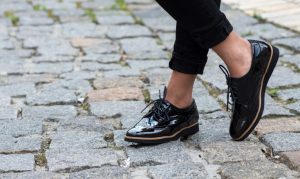Advancements in Athletic Shoes
Humans have been wearing shoes for thousands of years with the main purpose of protecting one’s feet from the ground and the weather. The first known shoes were a pair of sandals excavated from the Fort Rock Cave in Oregon, USA and dates back to approximately 7000 B.C.
Throughout most of history shoes were very simplistic pieces of clothing primarily used for protecting feet from the situation at hand, with little to no emphasis on increasing the abilities of the person wearing them in any way. With advances in research and technology in recent history, however, shoe’s have become much more diverse and sophisticated serving a higher purpose than just protecting the feet from the elements.
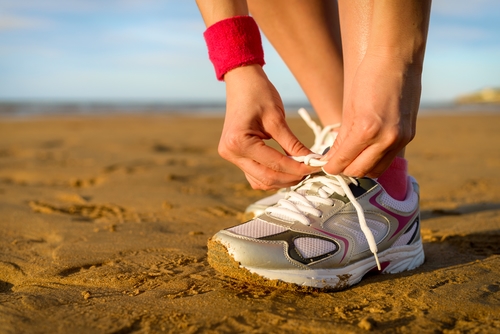
This is especially the case regarding athletic shoes which have become highly advanced pieces of equipment. Athletic shoes are very diverse depending on the sport that they are meant for and go through extensive research to make them ideal for each specific sport. Whether it is cleats used for field sports, shock absorbing material used in basketball shoes or higher ankle support used in football shoes, athletic shoes have taken on many forms, unique to each individual sport.
This article will examine some of the advanced features that have been incorporated into athletic shoes to make the experience as comfortable and practical for the athlete wearing them.
Cleats used for better traction
Cleats, also known as studs, are an addition to the bottom of shoes, which allow for the wearer to have more traction on soft and slippery surfaces. There are various sports where cleats are worn such as soccer, rugby, baseball, track and field and ice climbing. These sports each have differing cleat styles, each intended to serve a different purpose, which can be classified into 4 groups.
Grass cleats
Grass cleats are used in several different sports which are all played on natural grass or artificial turf. Some of the most popular sports that use this type of stud are soccer, rugby, football and baseball. In all of these sports, the shoes are fairly similar having several rounded studs on the bottom of the sole to give the players more traction on the field.
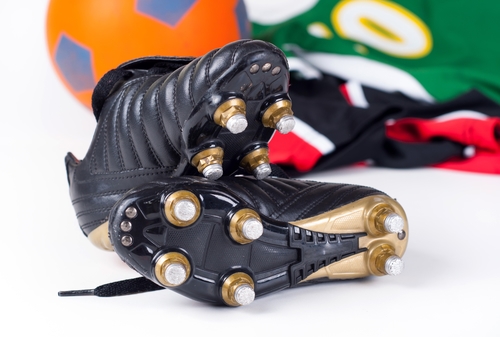 As the studs sinks into the soft ground below, the cleats purpose is to essentially lock itself into the ground and stop the player from sliding too far, especially when they are accelerating or decelerating.
As the studs sinks into the soft ground below, the cleats purpose is to essentially lock itself into the ground and stop the player from sliding too far, especially when they are accelerating or decelerating.
The varied tenderness of the surfaces used in these sports ultimately determines how many studs the shoes should have and how long each stud should be. For example, in the case of soccer, a player would wear shorter cleats on a dry field and longer cleats if the field is wet and soft. When playing on artificial turf, players typically wear turf cleats which have a large amount of very short studs.
Track spikes
This type of cleat is much different than that of grass cleats. Instead of having a long rounded stud, a track spike is a much shorter, smaller and pointier stud, usually made out of metal, plastic or ceramic.
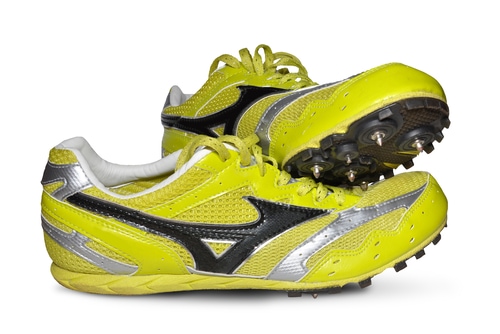 These studs are designed with a sharp point so that they could pierce the hard rubberized surface of the track. The intention of this stud is similar to that in grass cleats, giving the competitor more traction while running, but with more emphasis on the acceleration of the runner.
These studs are designed with a sharp point so that they could pierce the hard rubberized surface of the track. The intention of this stud is similar to that in grass cleats, giving the competitor more traction while running, but with more emphasis on the acceleration of the runner.
Ice cleats
Also known as crampons, this style of cleat is attached to an ice climbers boot for superior traction on ice and snow. Crampons are made with solid pieces of steel alloy or light weight aluminum with hard and rigid spikes to dig deep into the ice. This is a very specialized type of gear used for both ice climbing and crossing glaciers or snowfields.
Shock absorption
There are several sports which put a big strain on athletes knees and hips from having consistent heavy contact with the hard floor below. The two most popular of these sports are basketball and long distance running. In basketball, players are constantly running and jumping on a hard wooden court, causing a lot of strain on their joints. Long distance running has a similar strain on the joints as competitions usually take place on hard surfaces such as concrete.
In both of these sports, and other like them, athletes need to have some sort of shock absorption technology incorporated into their shoes to minimize the impact and strain on their joints. Shoes for these sports have all sorts of mechanisms incorporated into them to reduce the impact that the players joints receive.
For example, a simple version of a shock absorber is a style of shoe which has an air chamber in the sole. This air chamber, usually made out of plastic, compresses when there is a hard impact with the ground, transferring a large amount of the impact into the air chamber.
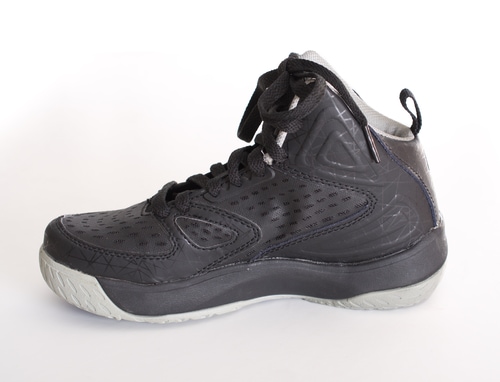
A more sophisticated version of a shock absorber built into shoes is an actual spring like mechanism at the base of the heel. This type of shoe allows for a large portion of the impact to be transferred into the spring putting a much lower strain no the wearers joints.
Ankle support
Another major area of advancement in athletic shoes is greater ankle support. This is especially needed in sports where the competitors change direction often, usually at high speeds. Two popular sports which require greater ankle support that come to mind are american football and basketball.
In both of these sports, there are several players who require to run at high speeds and change their direction very quickly to beat their opponent. As a result, shoe manufacturers put a heavy emphasis on creating shoes with a higher back section, wrapping around the ankle to give it more support.
